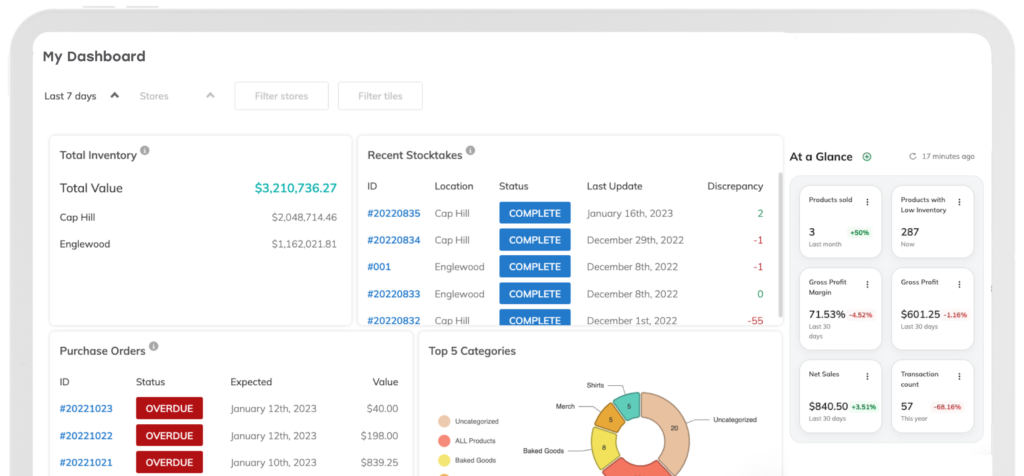
9 Coffee Shop Inventory Management Hacks Every Owner Needs To Know
Ever wondered why some coffee shops run like clockwork while others, no matter how good their coffee is, struggle to keep up? Often, the secret lies in their inventory management strategy. It’s not just about counting every cup you pour; it’s about optimizing your operations to reduce waste, boost profits, and ensure that every customer leaves satisfied.
From blends to the experience, every coffee shop is different. But when you break it down, all successful coffee shop owners follow proven inventory tracking strategies. Let’s explore practical strategies that can help you avoid stockouts, reduce waste, and keep your coffee shop profitable.
What You'll Learn In This Blog
- Benefits of optimizing your coffee shop inventory
- 9 best practices for coffee shop inventory management
- 1. Take regular inventory counts
- 2. Track modifications and substitutions
- 3. Build bundles and recipes
- 4. Monitor expiration dates
- 5. Set min/max reorder levels
- 6. Rethink your organization
- 7. Train your staff
- 8. Monitor key metrics
- 9. Focus on strong vendor relationships
- How these two coffee shops mastered their inventory with Thrive?
Benefits Of Optimizing Your Coffee Shop Inventory
Reduce waste
Not only is food waste bad for the environment but it’s bad for your profits. Every time you throw away spoiled milk or excess menu items, you’re essentially putting money in the trash. By managing inventory for perishable items, you can make every dollar you spend count.

Prevent stockouts
We’ve all been there, you swore you remembered having another case of almond milk in the back but it’s not there, and you have a line of customers at the counter. Best-case scenario, one of your employees runs to the nearest grocery store. In the worst case, you turn customers away. With proper inventory management, you will feel confident about meeting customer satisfaction.
Boost profit margins
Most independent coffee shops have a 15% profit margin. While that may feel comfortable when things are running smoothly, having a tight inventory management system is essential for controlling costs if your business gets hit with an increase in rent, construction, or economic challenges.
The Power Up Podcast: Stone’s Beer & Beverage Market
Stone’s Beer & Beverage Market grew their wholesale business from 0 to 150 accounts in two years to offset the loss in business during construction. Discover how owner Nick did it.
Automate Your Backoffice
Your employees are most valuable when interacting with customers, filming new latte art for social media, and forming partnerships with local bakeries. With effective inventory management, you reduce tedious and time-consuming tasks for your team.
Support Scalability
If you don’t have strong inventory control with one sales channel, opening a new location or expanding to wholesale may feel intimidating. By optimizing and standardizing your coffee shop inventory you have a strong foundation to replicate success. This also makes it easier to analyze and compare performance across different channels, helping you identify areas for improvement and make informed decisions about further expansions.

9 Best Practices For Coffee Shop Inventory Management
1. Take regular inventory counts
Cycle and full-inventory counts are essential for making sure what you have in stock matches what is in your inventory system. We recommend scheduling counts daily for products with a high daily turnover and perishability, like milk, and then weekly or even monthly for bulk products without a shelf life, such as cups.
While this may sound like a big commitment, using an inventory management software like Thrive Inventory, helps automate the process and identify discrepancies early before you discover out of stock items.
Free Kit: Stock Counting
Learn how to complete a stock count step-by-step with confidence by downloading our free Stock Count Kit.
2. Track modifications and substitutions
Give customers exactly what they want with options like oat milk and flavorings. Modifiers and substitutions allow you to customize an order at your point of sale system. By tracking stock levels for modifications and substitutions throughout the day, you always have real time visibility. This will streamline your ordering processes by always knowing how much you have on hand and when to reorder.
Simplify Modifiers And Substitutions With Thrive Inventory
Automate the process of Modifiers without complicated spreadsheets. When connected with Thrive Inventory, you always have accurate stock counts and reporting. Stop guessing how many pumps of hazelnut syrup you have left or wasting time on nightly cycle counts to update your inventory.

3. Build bundles and recipes
Chances are your to-go latte always consists of espresso, a cup, paper sleeve, and lid. Similarly, your homemade scones are the same with every batch. Bundle and recipe inventory management updates stock levels for offerings that always combine the same components.
Pure bundling combines multiple component-level products or ingredients in a new way that customers can only purchase as a bundle. For instance, the pump of syrup and milk for a latte. Customers can’t purchase the milk or the pump of syrup separately but can purchase them in their final product form as a latte.
Meanwhile, mixed bundling refers to products that have components combined together to form a unique product. However, customers can also purchase the individual components separately. Curated gift baskets are a great example for a coffee shop. Customers can purchase a pack of beans, a coffee mug, and a bakery item as a gift or buy a coffee mug right off the shelf.
Lastly, recipes take individual ingredients, such as chocolate chips and flour for artisan muffins, and turn them into a new final component. Like pure bundles, customers cannot purchase the ingredients separately. Recipes are especially helpful for final products that you will not want to be broken back into ingredients, like a batch of muffins.
Power Up
Have recipes and bundles in your coffee shop? Learn how to track them in your inventory system with our guide.

4. Monitor expiration dates
Expiration date tracking isn’t just about minimizing waste. It also directly impacts the quality and safety of the products you’re serving every day. When you receive a new order of perishable products, record their expiration date in your inventory management system.
Using the FIFO (first in first out) inventory management method is a great way to minimize spoilage of perishable goods. This ensures that you move out products in the order you received them in.
Look at your expiration date reporting weekly, if not daily. If products are coming up on their expiration date, consider tactics that move them out the door. Offer day-old pastries at a 50% discount or give children a free cup of hot chocolate to use up extra milk.
5. Set min/max reorder levels
Minimum reorder levels determine at what point you need to reorder a product so you don’t run out of stock. Maximum reorder levels let you know the maximum quantity you can store on hand. Let’s break it down. You currently have four bags of coffee beans for drip coffee. When you finish a bag and only have three (your minimum reorder level), you know it’s time to place an order to your coffee wholesaler. However, you can only have room to store seven bags (your maximum reorder level) of coffee beans at a time. That means you would list four bags on your next purchase order.
It’s important to review your min/max reorder levels seasonally. You need to keep changing trends in sales volume in mind to appropriately meet customer satisfaction. Demand forecasting is a great tool to help you gauge your product turnover.
Reorder On Repeat With Thrive Inventory Management
Streamline re-ordering and know before you run low with minimum and maximum stock levels so you always have just enough.
6. Rethink your organization
A well-organized storage system is the backbone of effective coffee shop inventory management. Clearly label items and group similar products together. This saves time during busy shifts and reduces the risk of errors, like using the wrong syrup or grabbing expired milk. Additionally, keeping storage areas clean and clutter-free to streamline operations and maintain compliance with health and safety regulations.

7. Train your staff
Your inventory management system will only work for your coffee business if your staff complies with it. We suggest assigning specific employees to different tasks for your coffee shop inventory. For instance, one employee can be in charge of checking expiration date reporting and another can be in charge of cycle counting milk. Writing detailed SOPs and hosting in-person team training sessions offer opportunities for employees to practice and ask questions.
This offloads the responsibility on coffee shop owners while allowing team members to step up. However, don’t forget to cross-train employees on different responsibilities so your inventory system still runs smoothly if someone is on vacation or leaves.

8. Monitor key metrics
Inventory valuation, turnover, shrinkage, and cost of goods sold are a few of the key reports cafe owners should view on a daily basis. These reports will help you identify areas where your business might be losing money or wasting resources.
Knowing your inventory valuation gives you visibility into your revenue potential and where it’s tied up. COGS helps you understand the profitability of your menu items, allowing you to adjust pricing or ingredient sourcing accordingly. Inventory turnover reveals how quickly stock is being sold and replaced, indicating whether you’re overstocking or understocking certain items. Meanwhile, tracking shrinkage—losses due to theft, spoilage, or errors—helps pinpoint inefficiencies in your inventory process.
9. Focus on strong vendor relationships
By fostering open communication and mutual trust with your vendors, you can ensure a consistent supply of high-quality ingredients, navigate market fluctuations with ease, and benefit from cost-effective pricing structures. Regular communication and transparency about customer preferences and sales trends help suppliers adapt to market demands so that your coffee shop always receives the best possible products.
Additionally, a strong supplier relationship allows for personalized service, where suppliers can tailor their offerings to meet your specific needs, such as adjusting roast profiles or sourcing unique beans. This gives your coffee shop a unique value proposition compared to others your vendors are serving.

How These Two Coffee Shops Mastered Their Inventory With Thrive?
Tradition Coffee Roasters
Tradition Coffee Roasters experienced a significant transformation in their retail offerings, thanks to Thrive Inventory’s comprehensive reporting suite. Initially, their shelves were stocked with coffee equipment like pour-over makers, but after analyzing the Unsold Inventory Report, they discovered these items had a low turnover rate. Armed with this data, Lindsey, co-owner of Tradition Coffee Roasters, made the strategic decision to remove these products from future orders. Instead, she introduced locally made snacks and treats that proved more popular and profitable with customers.
Lindsey discovered how Thrive Inventory’s reports enable her team to make informed, data-driven decisions rather than relying on intuition. For instance, when considering the purchase of a new, high-end espresso machine, they consulted the customer data on espresso, latte, and cappuccino sales. This approach allowed them to assess the potential return on investment and make a decision that aligned with their business goals.

Lindsey explained, “We’re very passionate coffee people. So we’re like, of course, we should offer this funky new espresso. But it was really interesting to know how few people actually ordered espresso, and our espresso is award-winning. Like of all the coffee shops, we probably would be the one you’d want to order an espresso shot from. But then to see how low the number was of people actually drinking a shot of espresso, it’s like, oh another three thousand dollar grinder is not a good investment. So I’ll come up with another kind of latte and that’s a better way to spend those dollars. And so it was cool to actually see that.”
Customer Success: Tradition Coffee Roasters
Discover exactly how coffee shop owner Lindsey Burik turned to Thrive Inventory, powering informed business decisions.
Sagebrush Coffee
Matt Kellso, founder and owner of Sagebrush Coffee, has been passionate about coffee for as long as he can remember. As a child, he would snack on coffee beans straight from the pantry, treating them like candy. This early fascination grew into an obsession that followed him into adulthood.
In 2012, Matt turned his passion into a career by launching Sagebrush Coffee as an e-commerce store. Initially aiming to compete with affordable coffee options like Starbucks, he soon shifted his focus to delivering the highest-quality coffee directly to customers’ homes.
However, in order to optimize his costs and work with the best coffee farmers, Matt orders for the year in bulk. Then, throughout the year, he uses product marketing to figure out where he’s going to have the best success selling it across a diversified sales channel strategy. With the use of Thrive Inventory, Matt shares, “We track our inventory, products, and bundles across several channels and get the reporting to be able to buy just right. Good inventory management is vital for a business to be profitable, and we wouldn’t be there without Thrive Inventory.”
The Power Up Podcast: Sagebrush Coffee
According to Matt, marketing should guide your sales channel strategy. Tune into Matt’s story on how he’s expanded Sagebrush Coffee over the years.
Final Thoughts: Elevating Your Coffee Shop With Inventory Management
Whether you’re a seasoned owner or just starting out, these coffee shop inventory management strategies can streamline your operations and enhance customer satisfaction. As you continue to refine your inventory processes, remember that data-driven decisions are key to making informed choices about your menu offerings, pricing, and overall business strategy. By mastering inventory management, you can focus on what truly matters—serving exceptional coffee and creating an atmosphere that keeps customers coming back for more.
The Newsletter For Small Businesses
Weekly expert insights, industry trends, and inspiring stories designed to help you run your business with confidence.
The Only Inventory System That Actually Helps You Run A Healthy Business
Thousands of customers all over the world use Thrive Inventory to run a healthy business.
Thrive Inventory gives you control over all your inventory, sales channels, and metrics, allowing you to make the right decisions at the right time.
Keep Reading

The Newsletter For Small Businesses
Weekly expert insights, industry trends, and inspiring stories designed to help you run your business with confidence.
Try Thrive Inventory For Free
Add Thrive Inventory to your business and maximize your potential. With powerful and easy-to-use products, it’s time to take control of
your business and see what you can do with Thrive.




